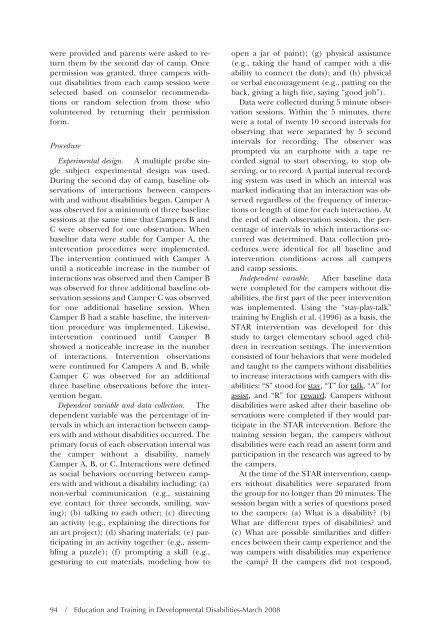Download the Journal (PDF) - Division on Autism and ...
Download the Journal (PDF) - Division on Autism and ...
Download the Journal (PDF) - Division on Autism and ...
You also want an ePaper? Increase the reach of your titles
YUMPU automatically turns print PDFs into web optimized ePapers that Google loves.
were provided <strong>and</strong> parents were asked to return<br />
<str<strong>on</strong>g>the</str<strong>on</strong>g>m by <str<strong>on</strong>g>the</str<strong>on</strong>g> sec<strong>on</strong>d day of camp. Once<br />
permissi<strong>on</strong> was granted, three campers without<br />
disabilities from each camp sessi<strong>on</strong> were<br />
selected based <strong>on</strong> counselor recommendati<strong>on</strong>s<br />
or r<strong>and</strong>om selecti<strong>on</strong> from those who<br />
volunteered by returning <str<strong>on</strong>g>the</str<strong>on</strong>g>ir permissi<strong>on</strong><br />
form.<br />
Procedure<br />
Experimental design. A multiple probe single<br />
subject experimental design was used.<br />
During <str<strong>on</strong>g>the</str<strong>on</strong>g> sec<strong>on</strong>d day of camp, baseline observati<strong>on</strong>s<br />
of interacti<strong>on</strong>s between campers<br />
with <strong>and</strong> without disabilities began. Camper A<br />
was observed for a minimum of three baseline<br />
sessi<strong>on</strong>s at <str<strong>on</strong>g>the</str<strong>on</strong>g> same time that Campers B <strong>and</strong><br />
C were observed for <strong>on</strong>e observati<strong>on</strong>. When<br />
baseline data were stable for Camper A, <str<strong>on</strong>g>the</str<strong>on</strong>g><br />
interventi<strong>on</strong> procedures were implemented.<br />
The interventi<strong>on</strong> c<strong>on</strong>tinued with Camper A<br />
until a noticeable increase in <str<strong>on</strong>g>the</str<strong>on</strong>g> number of<br />
interacti<strong>on</strong>s was observed <strong>and</strong> <str<strong>on</strong>g>the</str<strong>on</strong>g>n Camper B<br />
was observed for three additi<strong>on</strong>al baseline observati<strong>on</strong><br />
sessi<strong>on</strong>s <strong>and</strong> Camper C was observed<br />
for <strong>on</strong>e additi<strong>on</strong>al baseline sessi<strong>on</strong>. When<br />
Camper B had a stable baseline, <str<strong>on</strong>g>the</str<strong>on</strong>g> interventi<strong>on</strong><br />
procedure was implemented. Likewise,<br />
interventi<strong>on</strong> c<strong>on</strong>tinued until Camper B<br />
showed a noticeable increase in <str<strong>on</strong>g>the</str<strong>on</strong>g> number<br />
of interacti<strong>on</strong>s. Interventi<strong>on</strong> observati<strong>on</strong>s<br />
were c<strong>on</strong>tinued for Campers A <strong>and</strong> B, while<br />
Camper C was observed for an additi<strong>on</strong>al<br />
three baseline observati<strong>on</strong>s before <str<strong>on</strong>g>the</str<strong>on</strong>g> interventi<strong>on</strong><br />
began.<br />
Dependent variable <strong>and</strong> data collecti<strong>on</strong>. The<br />
dependent variable was <str<strong>on</strong>g>the</str<strong>on</strong>g> percentage of intervals<br />
in which an interacti<strong>on</strong> between campers<br />
with <strong>and</strong> without disabilities occurred. The<br />
primary focus of each observati<strong>on</strong> interval was<br />
<str<strong>on</strong>g>the</str<strong>on</strong>g> camper without a disability, namely<br />
Camper A, B, or C. Interacti<strong>on</strong>s were defined<br />
as social behaviors occurring between campers<br />
with <strong>and</strong> without a disability including: (a)<br />
n<strong>on</strong>-verbal communicati<strong>on</strong> (e.g., sustaining<br />
eye c<strong>on</strong>tact for three sec<strong>on</strong>ds, smiling, waving);<br />
(b) talking to each o<str<strong>on</strong>g>the</str<strong>on</strong>g>r; (c) directing<br />
an activity (e.g., explaining <str<strong>on</strong>g>the</str<strong>on</strong>g> directi<strong>on</strong>s for<br />
an art project); (d) sharing materials; (e) participating<br />
in an activity toge<str<strong>on</strong>g>the</str<strong>on</strong>g>r (e.g., assembling<br />
a puzzle); (f) prompting a skill (e.g.,<br />
gesturing to cut materials, modeling how to<br />
94 / Educati<strong>on</strong> <strong>and</strong> Training in Developmental Disabilities-March 2008<br />
open a jar of paint); (g) physical assistance<br />
(e.g., taking <str<strong>on</strong>g>the</str<strong>on</strong>g> h<strong>and</strong> of camper with a disability<br />
to c<strong>on</strong>nect <str<strong>on</strong>g>the</str<strong>on</strong>g> dots); <strong>and</strong> (h) physical<br />
or verbal encouragement (e.g., patting <strong>on</strong> <str<strong>on</strong>g>the</str<strong>on</strong>g><br />
back, giving a high five, saying “good job”).<br />
Data were collected during 5 minute observati<strong>on</strong><br />
sessi<strong>on</strong>s. Within <str<strong>on</strong>g>the</str<strong>on</strong>g> 5 minutes, <str<strong>on</strong>g>the</str<strong>on</strong>g>re<br />
were a total of twenty 10 sec<strong>on</strong>d intervals for<br />
observing that were separated by 5 sec<strong>on</strong>d<br />
intervals for recording. The observer was<br />
prompted via an earph<strong>on</strong>e with a tape recorded<br />
signal to start observing, to stop observing,<br />
or to record. A partial interval recording<br />
system was used in which an interval was<br />
marked indicating that an interacti<strong>on</strong> was observed<br />
regardless of <str<strong>on</strong>g>the</str<strong>on</strong>g> frequency of interacti<strong>on</strong>s<br />
or length of time for each interacti<strong>on</strong>. At<br />
<str<strong>on</strong>g>the</str<strong>on</strong>g> end of each observati<strong>on</strong> sessi<strong>on</strong>, <str<strong>on</strong>g>the</str<strong>on</strong>g> percentage<br />
of intervals in which interacti<strong>on</strong>s occurred<br />
was determined. Data collecti<strong>on</strong> procedures<br />
were identical for all baseline <strong>and</strong><br />
interventi<strong>on</strong> c<strong>on</strong>diti<strong>on</strong>s across all campers<br />
<strong>and</strong> camp sessi<strong>on</strong>s.<br />
Independent variable. After baseline data<br />
were completed for <str<strong>on</strong>g>the</str<strong>on</strong>g> campers without disabilities,<br />
<str<strong>on</strong>g>the</str<strong>on</strong>g> first part of <str<strong>on</strong>g>the</str<strong>on</strong>g> peer interventi<strong>on</strong><br />
was implemented. Using <str<strong>on</strong>g>the</str<strong>on</strong>g> “stay-play-talk”<br />
training by English et al. (1996) as a basis, <str<strong>on</strong>g>the</str<strong>on</strong>g><br />
STAR interventi<strong>on</strong> was developed for this<br />
study to target elementary school aged children<br />
in recreati<strong>on</strong> settings. The interventi<strong>on</strong><br />
c<strong>on</strong>sisted of four behaviors that were modeled<br />
<strong>and</strong> taught to <str<strong>on</strong>g>the</str<strong>on</strong>g> campers without disabilities<br />
to increase interacti<strong>on</strong>s with campers with disabilities:<br />
“S” stood for stay, “T” for talk, “A” for<br />
assist, <strong>and</strong> “R” for reward. Campers without<br />
disabilities were asked after <str<strong>on</strong>g>the</str<strong>on</strong>g>ir baseline observati<strong>on</strong>s<br />
were completed if <str<strong>on</strong>g>the</str<strong>on</strong>g>y would participate<br />
in <str<strong>on</strong>g>the</str<strong>on</strong>g> STAR interventi<strong>on</strong>. Before <str<strong>on</strong>g>the</str<strong>on</strong>g><br />
training sessi<strong>on</strong> began, <str<strong>on</strong>g>the</str<strong>on</strong>g> campers without<br />
disabilities were each read an assent form <strong>and</strong><br />
participati<strong>on</strong> in <str<strong>on</strong>g>the</str<strong>on</strong>g> research was agreed to by<br />
<str<strong>on</strong>g>the</str<strong>on</strong>g> campers.<br />
At <str<strong>on</strong>g>the</str<strong>on</strong>g> time of <str<strong>on</strong>g>the</str<strong>on</strong>g> STAR interventi<strong>on</strong>, campers<br />
without disabilities were separated from<br />
<str<strong>on</strong>g>the</str<strong>on</strong>g> group for no l<strong>on</strong>ger than 20 minutes. The<br />
sessi<strong>on</strong> began with a series of questi<strong>on</strong>s posed<br />
to <str<strong>on</strong>g>the</str<strong>on</strong>g> campers: (a) What is a disability? (b)<br />
What are different types of disabilities? <strong>and</strong><br />
(c) What are possible similarities <strong>and</strong> differences<br />
between <str<strong>on</strong>g>the</str<strong>on</strong>g>ir camp experience <strong>and</strong> <str<strong>on</strong>g>the</str<strong>on</strong>g><br />
way campers with disabilities may experience<br />
<str<strong>on</strong>g>the</str<strong>on</strong>g> camp? If <str<strong>on</strong>g>the</str<strong>on</strong>g> campers did not resp<strong>on</strong>d,
















